During the webinar “Researching Your Dutch Ancestors,” the viewers had the most interesting questions. I got to address some of them during the webinar, but thought they all deserve a reply so I’m dedicating this post to answer some more. There were so many great questions that I will have inspiration for several follow-up articles, so please stay tuned and follow this blog or newsletter to read them all. In this first article, I will answer the questions about records in the Netherlands.
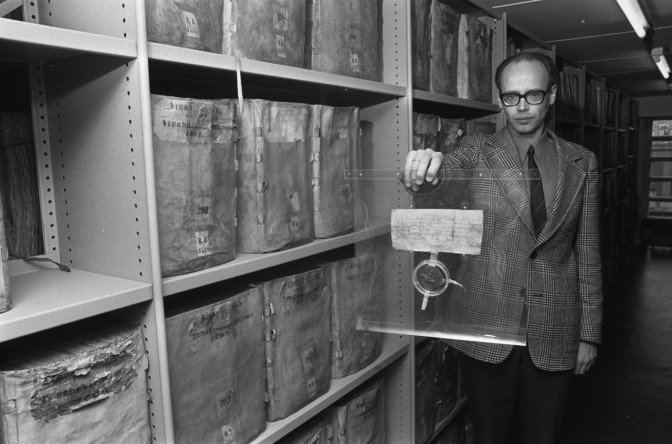
Records in the archives. Credits: Rob Mieremet, collection Nationaal Archief (CC-BY-SA)
Where to find online records
See also my article Where to Find Dutch Records Online.
Are there any online or web resources before 1600 for non Dutch speaking researchers to access?
First, for most places, records before 1600 are scarce. Church, town and tax records (baptisms, marriages, burials) often start after 1600. Court records sometimes start earlier, depending on the area. Most of these records have not been digitized, indexed or transcribed and can only be consulted as manuscripts in the archives. If they are available online, they will be mostly be on Dutch websites.
You can check the website Digital Resources in the Netherlands and Belgium to see what records might be available online for the region that you’re searching.
How do you access the Population Register?
Some population registers are available through WieWasWie. If you can’t find them there, check the website Digital Resources in the Netherlands and Belgium. They are not online for every municipality yet, although there are many projects underway to digitize and index them so if you can’t find them today, please check back next year.
Any tips for Dutch archive websites which are available in English too?
This depends on the archive: some choose to make at least their search pages available in English, some have no English website. The website that you will need depends on the place where your ancestors lived.
Some archives make their genealogy data available as Open Data. Open Archives presents all of that information in one website, which has an English interface.
Does the Netherlands have an equivalent to Find a Grave?
There are several Dutch websites that provide images of graves. See my article Online Cemeteries – Dutch Alternatives to Find a Grave. Keep in mind that graves are routinely cleared after a couple of decades so there may not be any graves left.
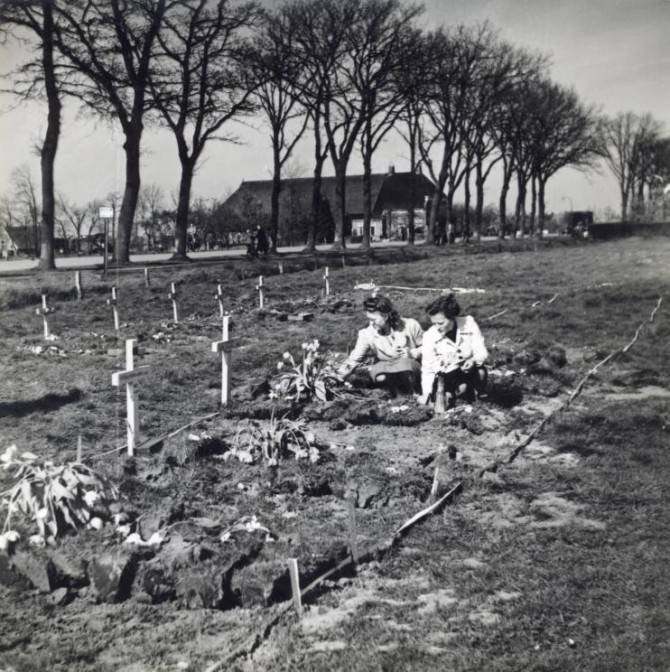
Dutch girls laying flowers on the graves of a temporary graveyard for killed Canadian soldiers. Edderwolde, The Netherlands, 1945.
Several years ago, I found many records on the Tresoar web site. Is that no longer working?
Tresoar, the provincial archives of Friesland, changed their website which unfortunately broke the old links. Click here for the new Genealogy page at Tresoar . They also have the website AlleFriezen [All Frisians], available in English, which currently has the civil registration records but they are working on a new version that will also have all the indexes that are currently on the Tresoar website.
How do you know the number to use as a shortcut?
This viewer watched me look up a scan in the “browse-only” image sets on Familysearch. To save time, I typed in the image number and jumped ahead to the correct page. The viewer wondered how I knew what number to type.
I prepared for the webinar by looking up the record beforehand. The index in WieWasWie gave me the record number, and I browsed the image set until I found the page that had that record. I wrote down the number of the scan so I could quickly find it again and not keep all the viewers waiting while I was browsing.
I’ve written an article about finding birth records that explains the steps in more detail: Ask Yvette – How to Find My Grandparents’ Birth Records.
Can some of these regional records be downloaded?
This depends on the website. Most websites will offer a download option, either as a button or link. Some have a clipping button on the tool bar that allows you to select a part of the image and save that to your hard drive. Some websites offer a shopping cart where you can buy high-resolution downloads of scans.
Are the digital scans at WieWasWie copyright free?
All of the digital scans at WieWasWie are of public records. The Archiefwet [Archive Act] of 1995 gives you the right to access public records, unless their material condition or other considerations prevent access, and create reproductions at your own costs. It does not place any limitations on what you may do with these reproductions.
Beware that individual websites may have terms of use that try to restrict what they want you to do with any scans. Some archives only allow personal use. However, this apparently limits the rights you have according to the Archiefwet, so whether this is legal or enforceable remains to be seen as there haven’t been any court cases that I know of. I’m not a lawyer, so don’t take my word for it.
The safest course is to download public records from a place that does not place restrictions on use.
How far does WieWasWie go back?
This viewer descends from Dutch immigrants who came over in the 1600s. Most records on WieWasWie don’t go back that far, it depends on the location. Some archives have just put the civil registration records online (since 1811), others have also made older records available. If you can’t find your ancestors in WieWasWie, you can check the website Digital Resources in the Netherlands and Belgium to see if records for that area are available elsewhere.
Sometimes when I use the advanced search on WieWasWie, it will show no results even though I know the record is there and the spelling is correct. Is this a glitch, or something else?
There could be several reasons:
- The name in the index is spelled differently than the name you search for. This can be an indexing error or an error in the original record. There was no concept of “correct” spelling until recently.
- You put the information in the wrong boxes. For example, you searched for “De Jong” as a last name instead of searching for “Jong” as a last name and “De” as a prefix.
- You searched for part of the name without using a wildcard or “Begins with”. For example, you searched for the first name “Johanna” while the person is recorded as “Johanna Geertruida.” Keep in mind that Dutch search engines only find exact matches: they only find exact matches.Go wild with wildcards!
- The record is not available in WieWasWie yet. WieWasWie is not complete and does not have all records that exist.
Different record types
See also my cheat sheet for records before 1811 and cheat sheet for records after 1811.
How do you go about finding military records?
This viewer had an ancestor from the late 1890s who deserted.
Military records are available at the National Archives in The Hague. Almost none are available online, so this will require an on-site visit. The records are organized by regiment, so you will have to know the regiment they served in.
There are three ways to find the regiment:
- Search the marriage supplements to see if your ancestor served (won’t work if he deserted before he married)
- Check enlistment records of the place where he lived when he was 19 years old. Some of them are available at Militieregisters.nl, otherwise these can be consulted at the local or regional archives.
- The National Archives have some indexes of military records online. They only cover a small portion of all military personnel, but it’s worth checking. The list of indexes includes some for the Landmacht [Army] and Marine [Navy]. If you find a hit, you can follow the link to the finding aid, where you can order scans of the record. This is a paid service.
Military service was five years long and usually consisted of 1.5 years of training and 3.5 years on ‘grand leave,’ which essentially meant you were back home, picking up your old life, but could be recalled any minute if there was an emergency. Many people who had emigration plans did not sit around waiting for 3.5 years and left, often with their families. They would have been seen as deserters and would not be allowed to return to the Netherlands or risk getting arrested.
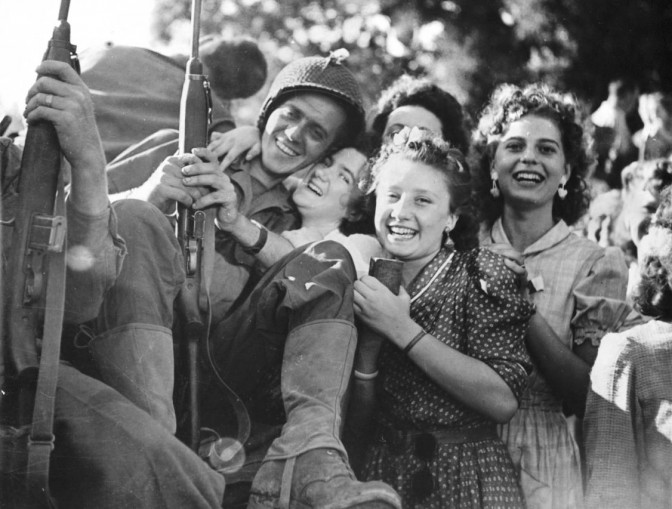
Allied soldier hugged by girls. Source: Collection Anefo, Nationaal Archief (CC-BY-SA)
What and why are there marriage banns?
See my article about Ondertrouw [Dutch word for marriage banns].
Do marriage supplements exist (or were done) for the early 1600s?
No, marriage supplements are part of the civil registration, which was introduced in 1811. It is rare to find them before that date. Sometimes, you will find a set of marriage permissions. If the two spouses came from two different places, the banns would be read in both places and the other town would give a certificate saying that they took place without opposition. The spouses would have to present that paper to the person officiating the marriage. In rare cases, these have survived. However, they rarely contain more information than what can be found if you check the marriage banns book of both towns.
Will the 1622 “census” ever be digitized?
There was no nation-wide census in 1622, the first one was held in 1795. This could refer to two sets of records (I only mentioned the first one during the presentation but later recalled that this might also refer to the second record group):
- Water board records [morgenboeken], kept by the Water Board of Rhineland, an organization to manage the water and dikes in the province of Holland. You can find scans online from the finding aid of the Water Board of Rhineland.
- Poll tax records [hoofdgeld], kept in the province of Holland. You will find these in local or regional archives. Some transcriptions are available in the members-only section of HoGenDa, the Holland Genealogical Database. This is available to members of the genealogical society Ons Voorgeslacht.
Are there any records for Gelderland, Holland in the 1700s? My ancestors owned property.
Yes, you should be able to find transfer deeds, tax records, estate divisions and possibly last wills and prenuptial agreements. Depending on whether the town where they lived had a notary or not, you will find these records in the notarial archives or the court archives. Most of these records are not available online and can only be accessed at the regional or local archives. They require a good understanding of Dutch handwriting and the archaic Dutch language.
You can check the Digital Resources website to see if any of these records happen to be available online for the towns where your ancestors lived.
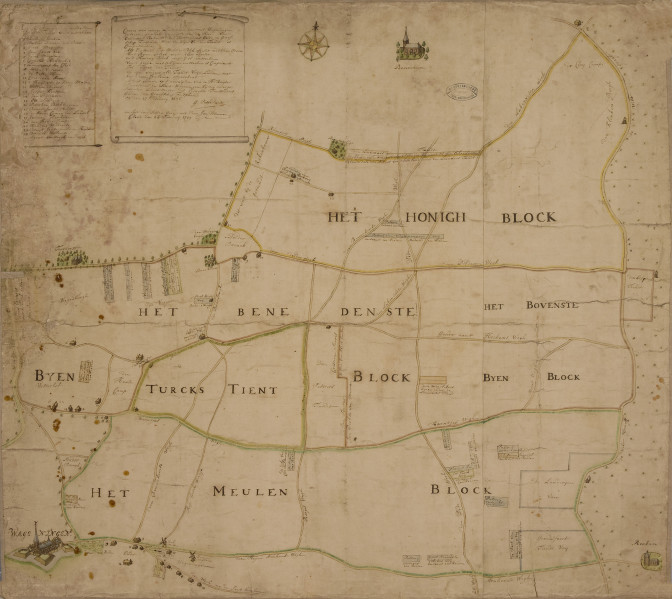
Map of lands around Wageningen, 1676 [1753] (Public Domain)
What is the Dutch word for tax records?
That would be belastingregisters [belasting = tax], but depending on the time and place, they could have many different names: verpondingskohier [land tax], schattingsregister or just the name of the tax: vuurstedenregister [hearth tax], speciekohier [spice register].
(Former) colonies and overseas parts of the Kingdom
Where do I search for Dutch info in Indonesia?
Many records relating to the former Dutch East Indies are kept in Indonesia. In Dutch archives, you will find records about people who worked for the Dutch or East Indies government and about soldiers who served in the Dutch East Indies Army (KNIL). If they worked for a corporation, the corporate archives may hold records too. Most of these records are not available online.
If you go to the Digital Resources website, you will find some links to online records for the area that is now Indonesia under “General and Overseas” > Internet. Many former Dutch East Indies records have also been microfilmed by the Family History Library. Check their online catalog to see what is available and for information on how to order the microfilms.
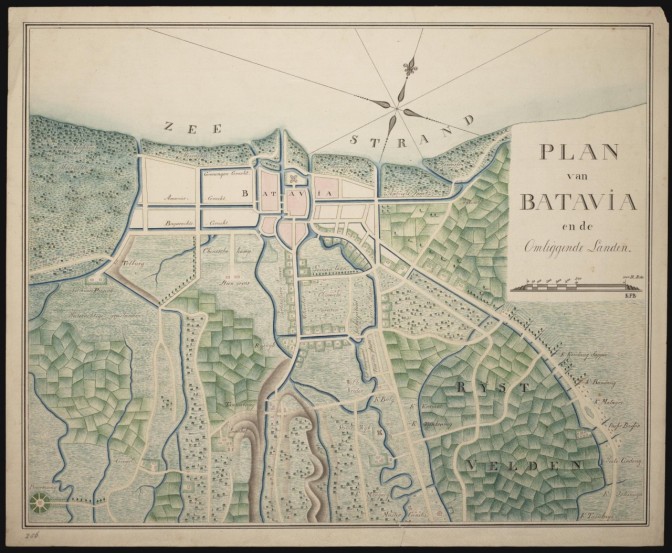
Map of Batavia, early 19th century. Credits: K.F. Busscher, collection National Archives (Public Domain)
Where would I request my ancestor’s KNIL military record from WWII? He was a POW from Java.
The KNIL was the Royal Dutch Indies Army. KNIL records are available at the National Archives in The Hague. They are not available online. For people born less than 100 years ago, you will need their permission or proof of death to consult the records.
If your ancestor was in a Japanese internment camp during World War II, you should be able to find his internment card online at the National Archives website, which is indexed. Go to the Japanese Internment Index to search for him.
How do I find records for the Netherlands Antilles?
The same types of records exist for the Netherlands Antilles as for the Netherlands. The civil registration records have been indexed in WieWasWie (no scans). If you go to the Digital Resources website, you will find some links to other online records for the Netherlands Antilles under “General and Overseas” > Internet > “Kingdom of the Netherlands.” Several Netherlands Antilles records have been microfilmed by the Family History Library. Check their online catalog to see what is available and for information on how to order the microfilms.
Some of the older Netherlands Antilles records, like the notarial and court records for the 17th and 18th century, are kept at the National Archives in The Hague, and available in self-service on microfiche at the Central Bureau for Genealogy in the same building.
Thank you
Thank you all so much for your interest in Dutch Genealogy, and for these wonderful questions. If your question hasn’t been addressed, stay tuned because I will write some more articles over the following weeks to answer questions about these topics:
- Names and naming patterns
- Finding immigrant ancestors
- Other questions (religion, boundaries, addresses, legal issues).
If you have any questions about these topics, feel free to leave a comment and I’ll include them in the articles.


My question during the webinar concerned Samuel Martini de Meurs.
My blog about my husband’s family in South Africa is http://www.quesnellpoolesouthafrica.wordpress.com . The research into his family is the most varied and most interesting of any that I have done, including Dutch, Welsh, Angolan (slave), German ancestors among others.
Thank you for such a good webinar.
Mary Beth
You’re welcome Mary Beth. I will discuss your question about Samuel Martini de Meurs in the next article, which will be published on 2 October. Fascinating to have such diverse ancestry. My ancestors come from just a few areas, which is why I love doing research for others and expanding my horizons.
I have been finding my ancestors on the WieWasWie.nl website but when I try to see the image I get an error message; Bestandsstructuur niet geldig. Do you know of anything I can do to fix this problem?
Hi Shannon,
That sounds like there is an issue at the website of the archive, but on your end. What is the WieWasWie link to the detail page that had the link to the image?
That was a wonderful webinar, Yvette. Congratulations and thank you.
I was unable to attend webinar, but just watched it. There was so much great information to assist with my Dutch van’t Hoff family.
Thank you so much,
You’re welcome, Karen! Don’t forget that in Dutch, “Van ‘t” would be considered prefixes, so search for “Hoff” as the surname to find records about your family.
Hi Yvette – I watched your webinar this weekend on-demand. Lots of great information – thank you! I’m in your queue for early 2016 – the anticipation is killing me! But since I watched the webinar, I did locate my 3rd great-grandfather’s emigration record from the province of Groningen through the Digital Resources website you mention. The record is great – as it told me he was one of three men from his town (Winschoten) to emigrate in 1870; he was a skipper at the age of 25; he was traveling alone; and his reason for emigration was to settle with his family in New York. Thanks!
Thanks so much for having such a great webinar, I have been ignoring the population registers however looking today I found the birthday of my 5x great grandmother!
I have a heck of a time trying to find my family name in the Netherlands, but that is where both of my parents were from.
Have you watched the webinar? I explain several of the most important resources, including several websites where you can do online research.
Hi Yvette
What does it mean when it says N.P. where a certain person should be on a family tree? Is it Not Public and why if someone has died 76 years ago would that be so? How else could that person be found with only a name (with questionable spelling) and a questionable date of birth and death?
Do you have a link or image? That is not a common abbreviation so I would have to look at the context to see if I can make sense of it.
Hello Yvette! Can you give some insight into finding records of Dutch people in Indonesia who married non-Dutch? I only have a name of my great-grandfather who was on the HMS.Java which was torpedoed when he was 33 years old – I have his death certificate but nothing else – I’m trying to find his family roots in Indonesia.
If it was a legal marriage, it should be recorded in the civil registration. In the East Indies, there were also many long-term relationships between European men and local women that did not result in marriage but did produce children. In that case, the children’s civil registration birth record would typically include a reference to their European father acknowledging the child as their own, sometimes as a separate record in the series of birth records later that year.
Civil registration records of Europeans in the Dutch East Indies were published in the Regeringsalmanak [Government almanac] and are indexed on RoosjeRoos. The original records are in Indonesia but scans are published on FamilySearch (see Search > Catalog and then search for the place). Most scans of Dutch East Indies civil registration records I’ve tried to access are only available in FamilySearch Family History Centers, and not from a regular computer outside a FHC.